The WOW effect: ScaleTrains.com N Scale Tier 4 GEVO
Last updated on: 2021-08-09
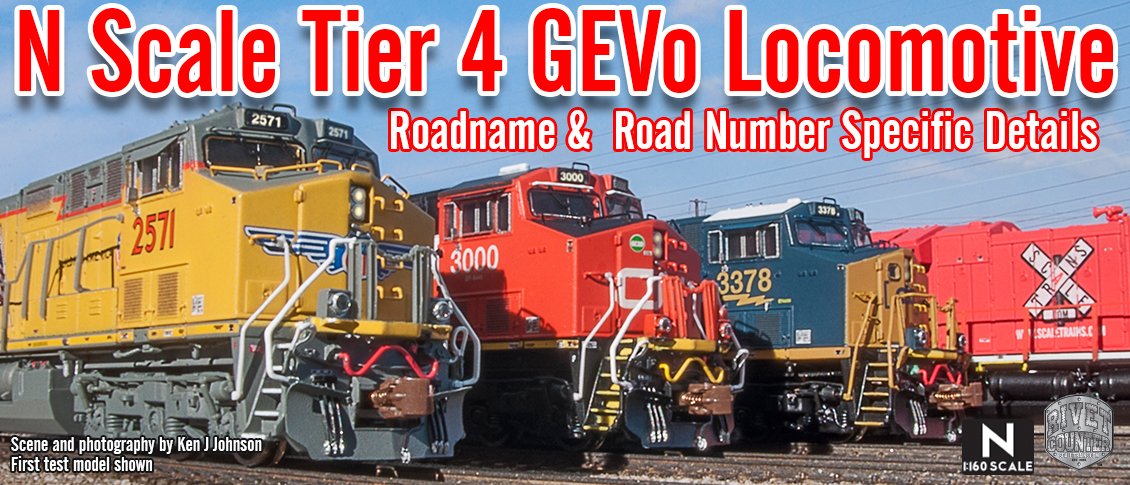
About the prototype
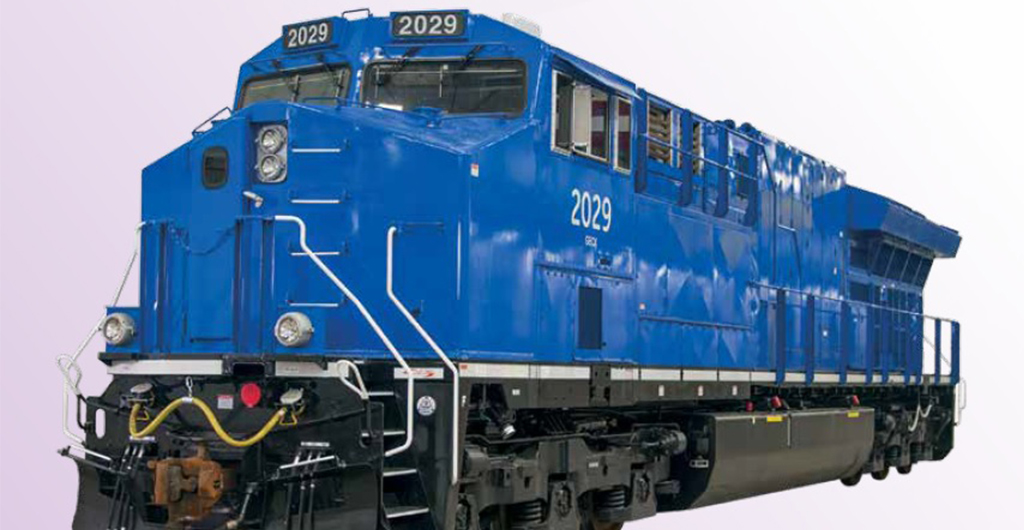
The General Electric Transportation ET44AC, often referred to as Tier 4 GEVO, is the most recent freight locomotive offered by GE, chiefly for the North American market.
Here is how ScaleTrains.com describes the prototype on its website:
Introduced in 2012, General Electric's Tier 4 GEVo Series represents the latest in diesel-electric locomotive technology. The GE Tier 4 GEVo is designed to meet increasingly stringent Environmental Protection Agency (EPA) emissions regulations.
The EPA “Tier” emissions standards are a series, or Tiers, of allowable emissions levels based upon a locomotives’ date of manufacture. The highest and most stringent tier level, Tier 4, sets maximum allowable NOx and hydrocarbon emissions levels for locomotives built for domestic use 2015 onward.
While similar in appearance to previous GE GEVo designs, the Tier 4 models featured a longer frame compared to their predecessors. This allows for a larger radiator “cab” (GE refers to the various sections of the long hood as “cabs”), and a "hump" over the engine cab for advanced exhaust treatment equipment.
Initially, a boxy housing filled the entire roofline on the blue-painted field test/demonstrator units. Due to changes in treatment equipment and clearance issues, the "hump" would decrease in size and shape into a boxy compartment around the exhaust on initial production units. This culminated in an angled compartment surrounding the exhaust manifold on the latest production versions (2016+).
Despite boxier engine cab rooflines and a radically styled radiator cab, the basic Tier 4 design shares a family appearance with GE safety cab-equipped units going back to the DASH-9s of the 1990s. It even includes the same 12-cylinder GEVo-12 series prime mover and 4,400hp as its predecessor model.
The Tier 4 units have proven to be popular with the major railroads including BNSF Railway, Canadian National, CSX Transportation, Norfolk Southern, and Union Pacific. While GE has settled on a basic carbody design to keep production costs down, there are notable variations and detail differences due to customer specifications.
With many units built for railroads across the US and in Canada, the Tier 4 GEVo can be seen operating nationwide in a variety of assignments.
And now for the review
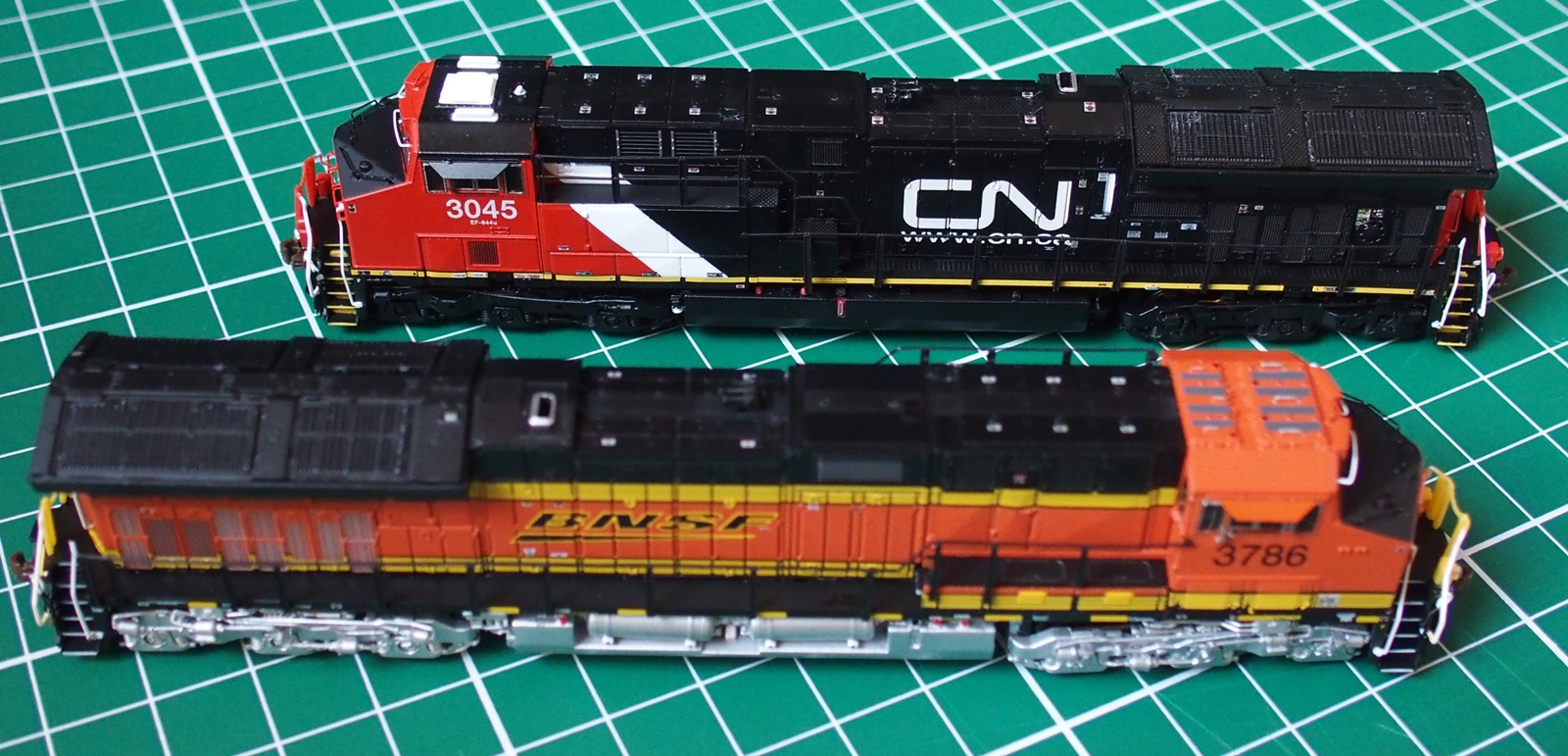
This is the only photo of the assembled model that I will publish in this article. There are so many better photos on the ScaleTrains.com website that I will not even try to compete. ALL individual models have been photographed from several angles, so you can really check out every detail before buying one of these engines. The photos of the pre-production models are just amazing. Yes, it's a model!
I will be very direct and to the point: WOW!
This is the most detailed N scale model loco, at this price point and out of the box, that I have ever seen. Without a shadow of a doubt, it outperforms the competition. Just see for yourself with the numerous photos of the production models on Scaletrains.com website. I was already very pleased with the level of detailing of Fox Valley Models and Rapido Trains, to name a few, but these Scaletrains.com models raise the bar far above the competition. The piping on the trucks and tank, the MU and trainline hoses on the pilot are detailed to a level never before reached.
And, unlike many other brands, the modeler does not have to add any parts to engine; all the details are already assembled and firmly secured to the model- I haven't lost one yet, unlike with the IMR SD40-2W that I reviewed previously.
The model is available for each of the class I railroads that acquired it, as well as in the GE demonstrator blue livery. In addition to the prototypical paint schemes, a fantasy paint scheme featuring the ScaleTrains.com herald is also available. Due to numerous details that vary from one model to the other, this product release represents no less than 12 different variations, the BNSF itself being available in 3 versions.
The variation points reside on the following elements:
- Trucks: Hi-Ad or C4 (A-1-A) for BNSF
- Engine cab, with 2 types of exhaust compartment
- Headlight: high cab mounted for NS, nose-mounted for all others
- Ditch lights, with or without rear ditch lights
- Cab door, with or without window
- Antennas: dome or farm array, of different shapes
- Tank fuel fills: single or double
- Handrails: two types
... and a few other railroad specifics.
The ScaleTrains.com model itself sports a unique combination of those features, that makes it a special model in its own right.
You can download here a detailed description of all variants where I have regrouped, in one single table, the features of all model types as listed on ScaleTrains.com website.
Unboxing

The model is packed in a nice red cardboard box, that is a bit higher than the usual jewel box and a bit more than twice as wide. So it will take a bit more space than 2 other locomotives on your shelves.
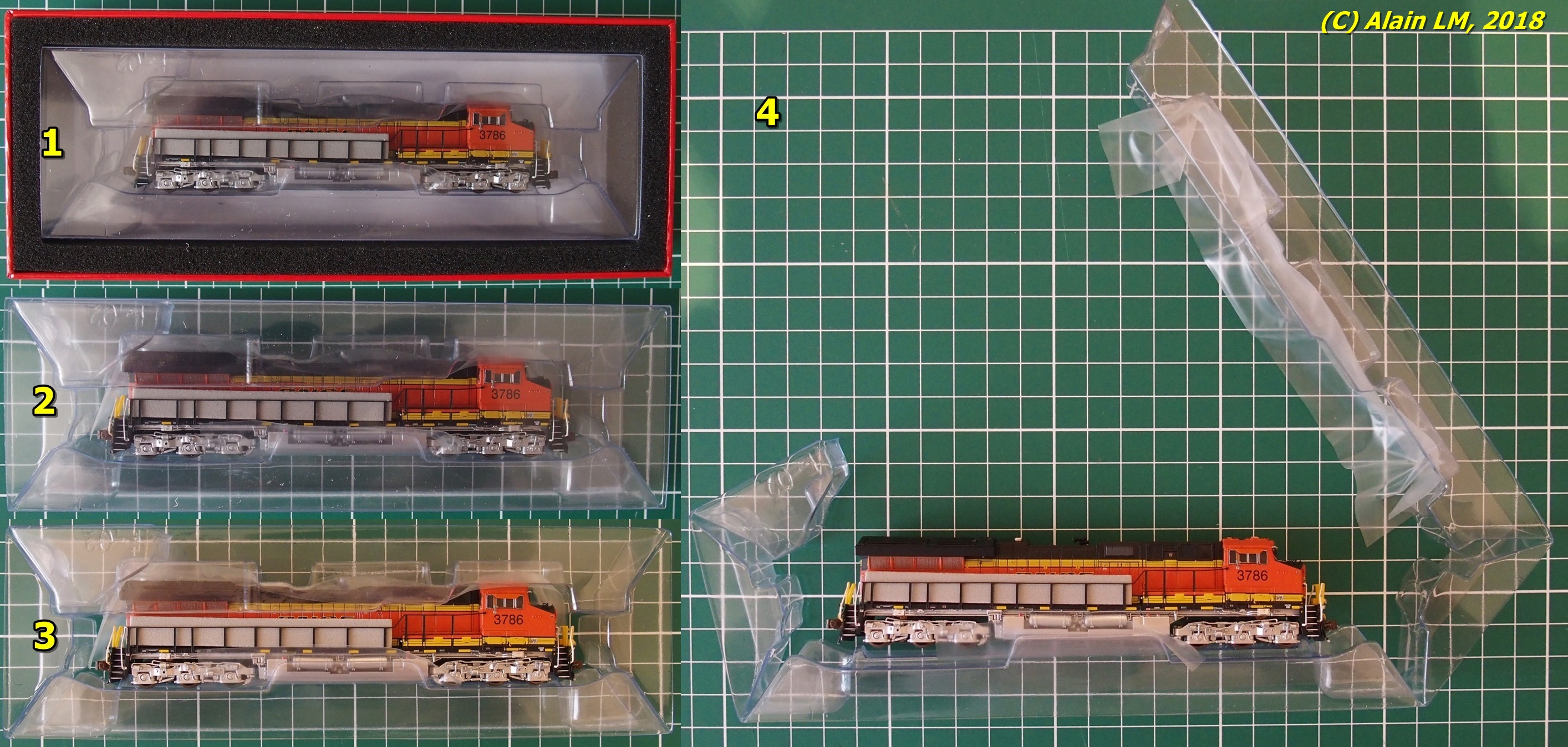
The locomotive is securely stored in a plastic "clamshell" holder, similar to what you can find on high-end N scale steam engines or on several HO models. I like very much this type of holder that can be used as a natural cradle when servicing the engine.
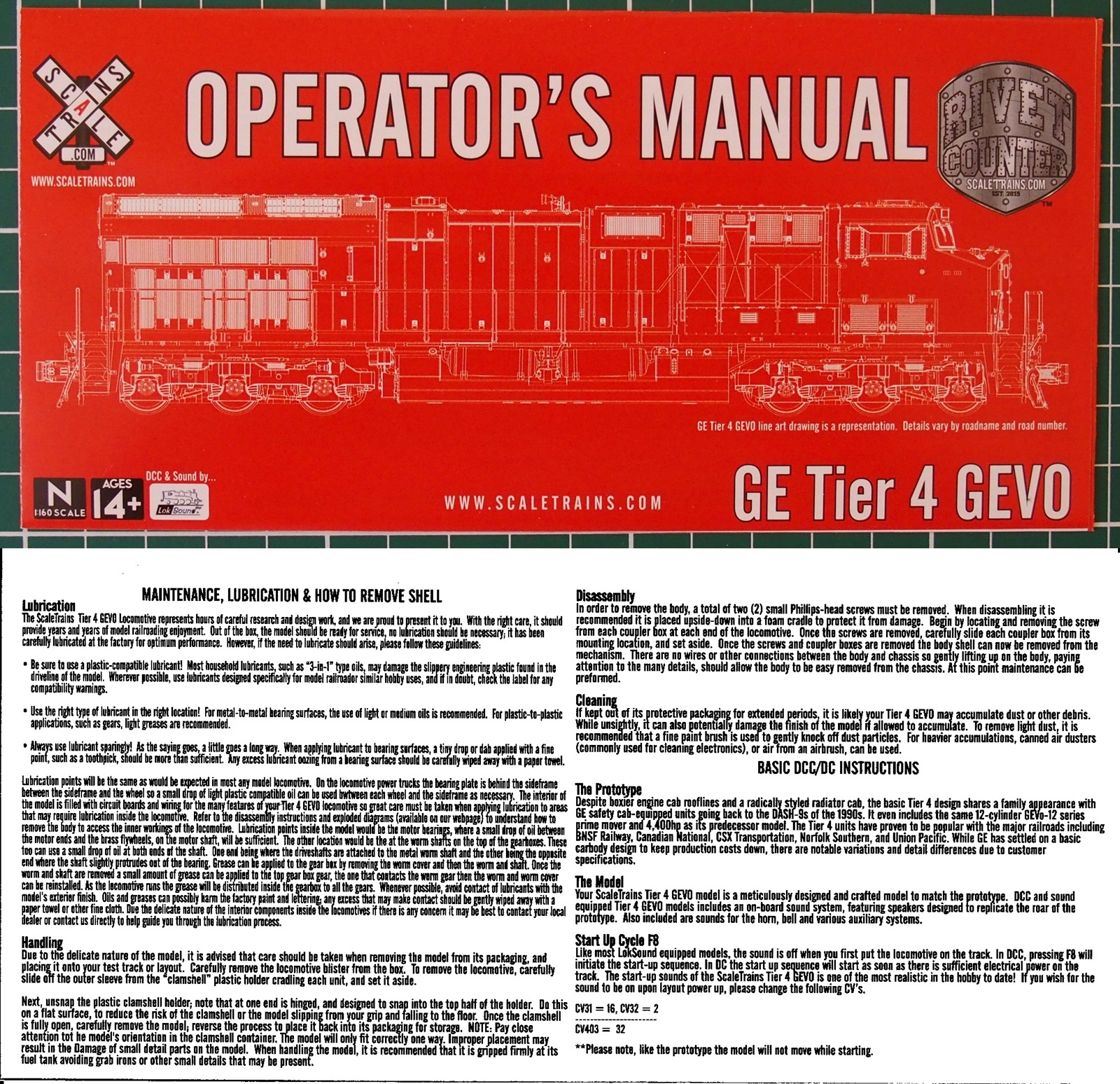
The Operator's Manual is printed with a very small font; not very easy to read, even with good eye glasses. It has 4 pages of text, essentially related to the DCC & Sound instructions. Fortunately, the manual is available for download in PDF on ScaleTrains.com website, so you can enlarge it on your screen. Note that the PDF file also contains the assembly drawing, that is not part of the printed manual.
First run
There is absolutely NO tuning required to move the engine. The DCC-Sound version starts moving slowly and smoothly at DCC step 1 (with a 128 step configuration). The DCC no sound equipped with the ESU LokPilot, out of the box, starts moving at step 1. The DC version starts moving at around 2 volts. In analog mode, the DCC-Sound version starts at around 8 volts.
Sound volume is properly tuned to my taste, i.e. not too loud. Conversely, at higher speeds, you will hardly hear the engine sound but you are not going to drive it like a TGV high-speed train, are you?
Pulling power seems to be at par with similar engines of other brands (see video below by DaBob's ManCave).
Couplers are the ScaleTrains.com plastic semi-scale E Type knuckle couplers. They are meant to look prototypical and to couple firmly; so no automatic uncoupling. The coupler box seems compatible with the one of Micro-Trains Line 1015/1016 coupler, so I guess that replacing it can be done pretty easily, if you'd like or need magnetic uncoupling.
Running an MU between one engine equipped with LokSound and the other with LokPilot requires a bit of tuning, even if out of the box and at constant speed, speed matching is quite OK. Defaults of LokPilot for acceleration and deceleration are not aligned to the LokSound project, no first thing is to set them at same value; secondly, the starting delay of the LokSound (CV124.2) must be disabled.
What's inside?
As properly explained in the manual, removing the shell requires first removing the couplers, that are actually mounted on the chassis. Each coupler is secured by a small Philips-head screw; once removed, gently push the coupler box from the inside; be careful not to damage one of the hoses on the pilot by doing so - it did happen to me but I was able to put it back in place. Then the shell can be freely removed; gently push from the bottom of the shell; there is some resistance in the back, so be careful.
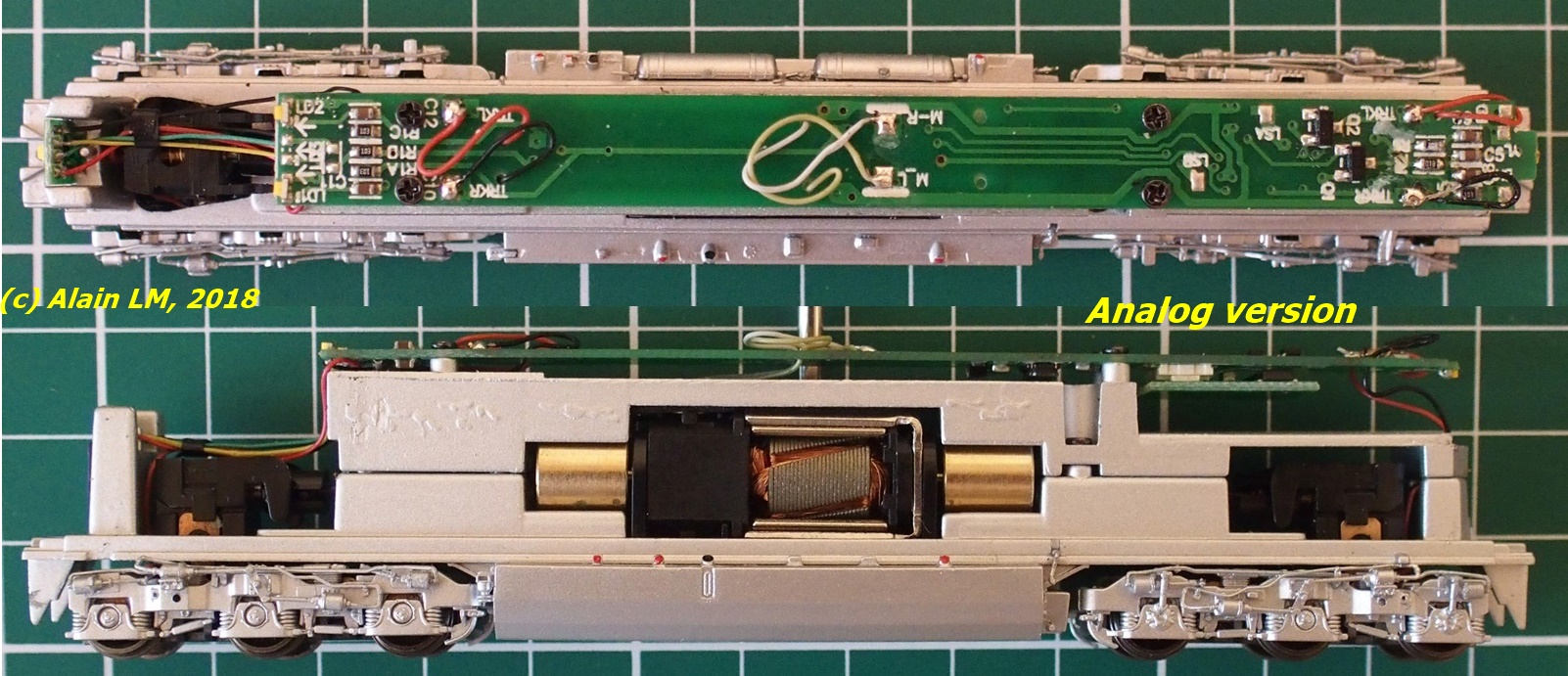

The design of the chassis is totally different from the split frame chassis type that the North-American manufacturers have adopted a few decades ago; it is closer to the design of European models. All six axles are powered and provide power pick-up. Power is driven to the circuit board from the trucks by wires - and not by the chassis. The motor is with 5-pole skew wound armature and with two flywheels, so similar to all modern N scale models. Note that the chassis is molded in a different color depending on the color of the underframe and trucks.
There are two LEDs mounted on the front of the circuit board for lighting the number boards; they cannot be controlled, so the number boards will be permanently lit. The rear light is on the other side of the circuit board. The front headlight and ditch lights are mounted on a separate small board, as well as the rear ditch lights when the model is so-equipped (this is the case for CN, not for BNSF and other RRs). Each ditch light LED can be controlled separately (Aux 1 and 2 for the front, Aux 3 and 4 for the rear), therefore allowing alternating ditch lights.
You can notice some small embossment on the side of the chassis; I initially thought that these were mysterious inscriptions, but looking at it more closely it is more likely to be a default of the mold rather than extraterrestrial sanscrit!
DCC and Sound
The model is proposed in two variations: DC-only and DCC-Sound factory-equipped with an ESU LokSound. There is no DCC-only factory-equipped version, so for those interested, you'll have to install the decoder by yourself. This is fairly easy, so no worries. I note a trend in the market not to propose any longer DCC-only (no sound) factory-equipped variants, but only either DC or DCC-Sound; this is true for Atlas and Rapido Trains with their latest announcements.
Next18
The model accepts DCC decoders (sound or no-sound) meeting the Next18 interface standard. You might see this term for the first time. Next18 is actually a European standard NEM 662 by the MOROP, which is the equivalent to a European NMRA if I may say so. Unfortunately MOROP documents are only available in French or in German. There is no equivalent NMRA standard, to my knowledge.
Obviously the number 18 in the name stands for the number of pins on the connector. There are two variants: Next18 (no sound) and Next18S (for Sound). The Next18 can accommodate 6 auxiliary outputs, in addition to the front and rear lights, whereas Next18S is limited to 4 auxiliary outputs, as 2 pins have to be used for the speaker. This model is equipped with a Next18S connector to be compatible with both sound and non-sound decoders.
I invite you to read the excellent article by Pierre B. on his blog LocGeek where he presents the various decoder interfaces that are currently being proposed.
I hereby salute the choice made by ScaleTrains.com to adopt a plugged-type decoder, as opposed to the replacement board type that is predominant in the North-American market. The only other US manufacturer that has gone this route is Fox Valley Models, to my knowledge, with NMRA 6-pin NEM 651 socket.
LokPilot installation and programming
I deliberately opted to buy one of my two locos without sound, both for financial reasons and because one sound loco per consist is enough for me - though ESU proposes features to phase shift some of the engine sounds between units in an MU consist for even more realistic effect. I purchased the ESU LokPilot decoder with Next18 connector, as the loco is shipped in DC without decoder.
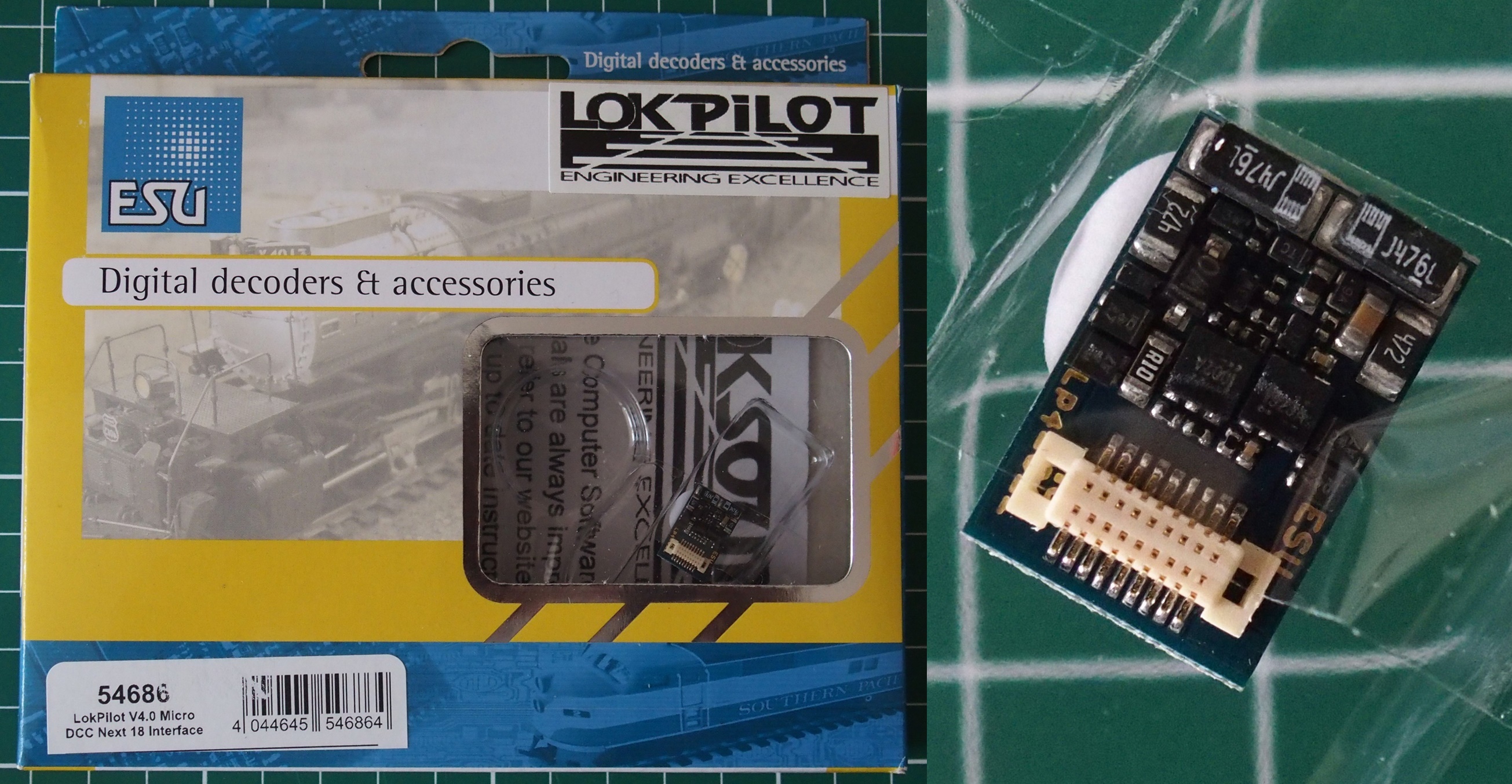
As often with ESU, the packaging is oversized. Look at the size of the decoder box compared to the decoder! Likewise, the packaging of the ESU LokProgrammer is exaggeratedly cumbersome, in comparison to the size of the programmer itself.

Once the shell is removed, the dummy analog plug is immediately accessible and can easily be detached from the circuit board by pressing it down. Plugging back the LokPilot is a bit more delicate, as it is upside down; after several attempts, I eventually seized it and pressed on the side with 2 nails, to avoid damaging the electronic components. It now seems to be securely in place; so let's see after some utilisation if it holds in position in the distance. The factory-installed LokSound is secured by a small piece of white foam between the decoder and the chassis; this is certainly a good idea to do the same with the LokPilot, just for security, even if the LokPilot is lighter and therefore less prone to fall.
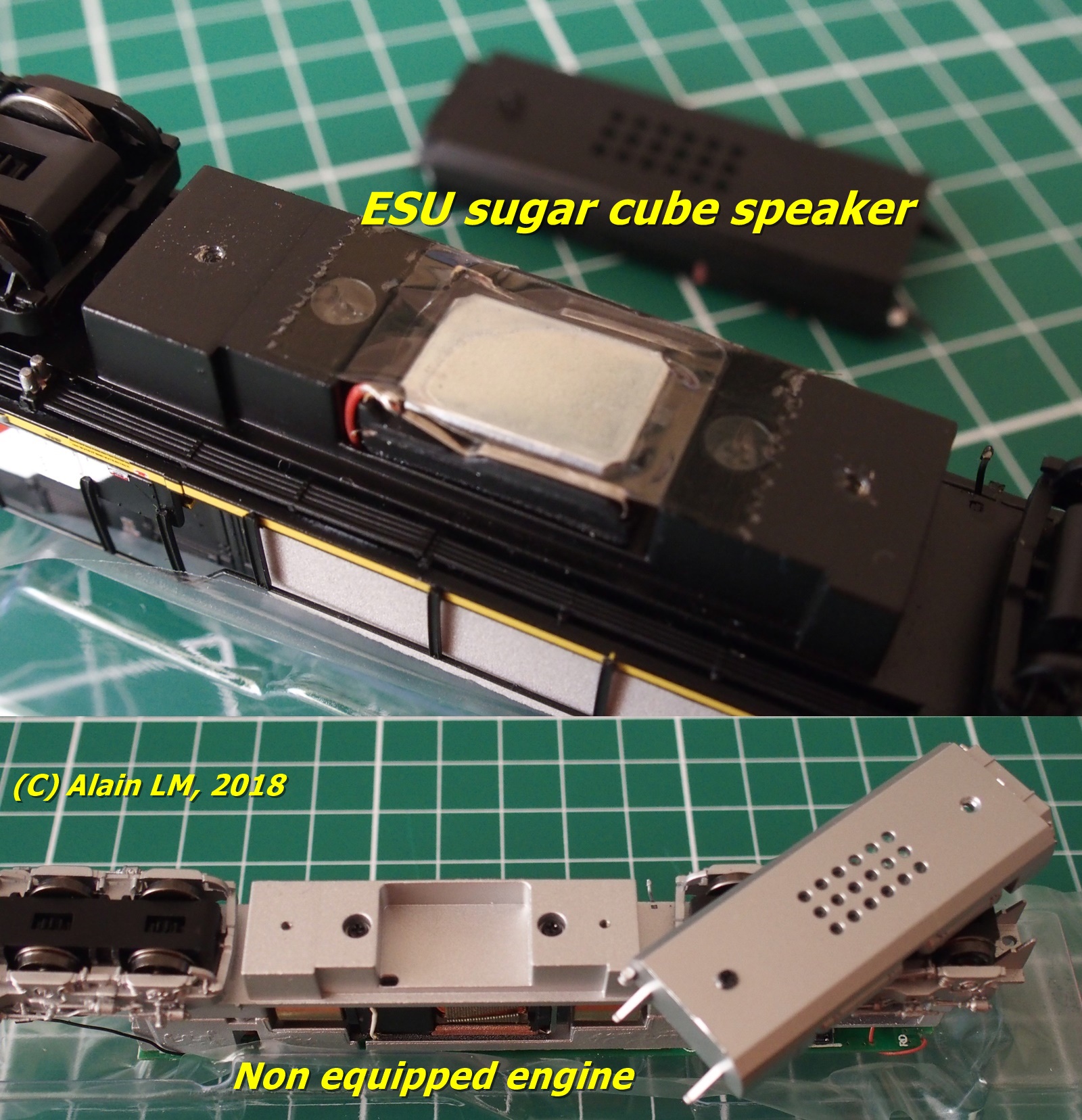
The loudspeaker is installed in the fuel tank, like in all model diesel engines. The fuel tank cover can easily be removed by unscrewing 2 tiny screws. Not surprisingly, the DC-only version is not fitted with a speaker, but the chassis is ready to house one, if you ever want to convert your model later; there is also a small hole to insert the wires. Dimension of the speaker reserved space: 17 x 11 x 4.5 mm. It looks like it has been designed for the ESU 50321 Sugar Cube speaker, but any of size 15 x 11 x 4.5 mm will fit.
DCC programming - LokProgrammer and JMRI
LokSound Configuration
I acquired an ESU LokProgrammer last year based on the increasing number of ESU LokSound equipped locomotives I run. This is obviously the tool of choice, as it allows extremely fast reading and writing of the decoder configuration, as well as upgrades of the decoder firmware. I would recommend sharing one of these at your club if you can. The pre-equipped sound decoder is an ESU LokSound Select direct/micro; this is the OEM version, and the main difference with the LokSound V4 "full fledge" is that you cannot load your own sounds. But it has all other features, notably "Full Throttle". Other than the decoder address, I have not made any changes to the configuration. Function mapping capabilities in the ESU decoders are very flexible, and you can easily make any change or tuning tweaks from the function map. Note that you can do the same from JMRI, with the same look and feel. The only difference with JMRI is that it will use the DCC protocol to read the decoder, which can take about 30 min for a LokSound decoder. So it is better to read from LokProgrammer first, then import to JMRI, and make only limited changes and reading from JMRI, if you don't have a LokProgrammer permanently with you.

LokPilot programming
Though indicated in the manual, there is - as I write this article - no available ESU configuration file on ESU download pages for the N scale versions of ScaleTrains Tier 4 GEVO (Only HO ones are available). This is not a big deal for the sound-equipped versions, as they come fully programmed, but does become an issue when you just want a DCC version without sound; the ESU LokPilot out of the box features a default configuration that does not match the custom sound version for this model. So I have modified the whole function map of the LokPilot to match the one of the sound version, obviously for non-sound functions. In this mapping, I have kept fixed ditch lights with F6 and added the possibility to set them to alternating blinking mode with F2, i.e. if using the horn (mapped to F2 on sound models) when approaching a grade crossing.
To save you time and help you avoid any headaches in understanding ESU function mapping, here are the LokPilot configuration files, in two forms: 1) ESU LokPogrammer, 2) CV list to be imported in JMRI via File->Import->ESU menu option.
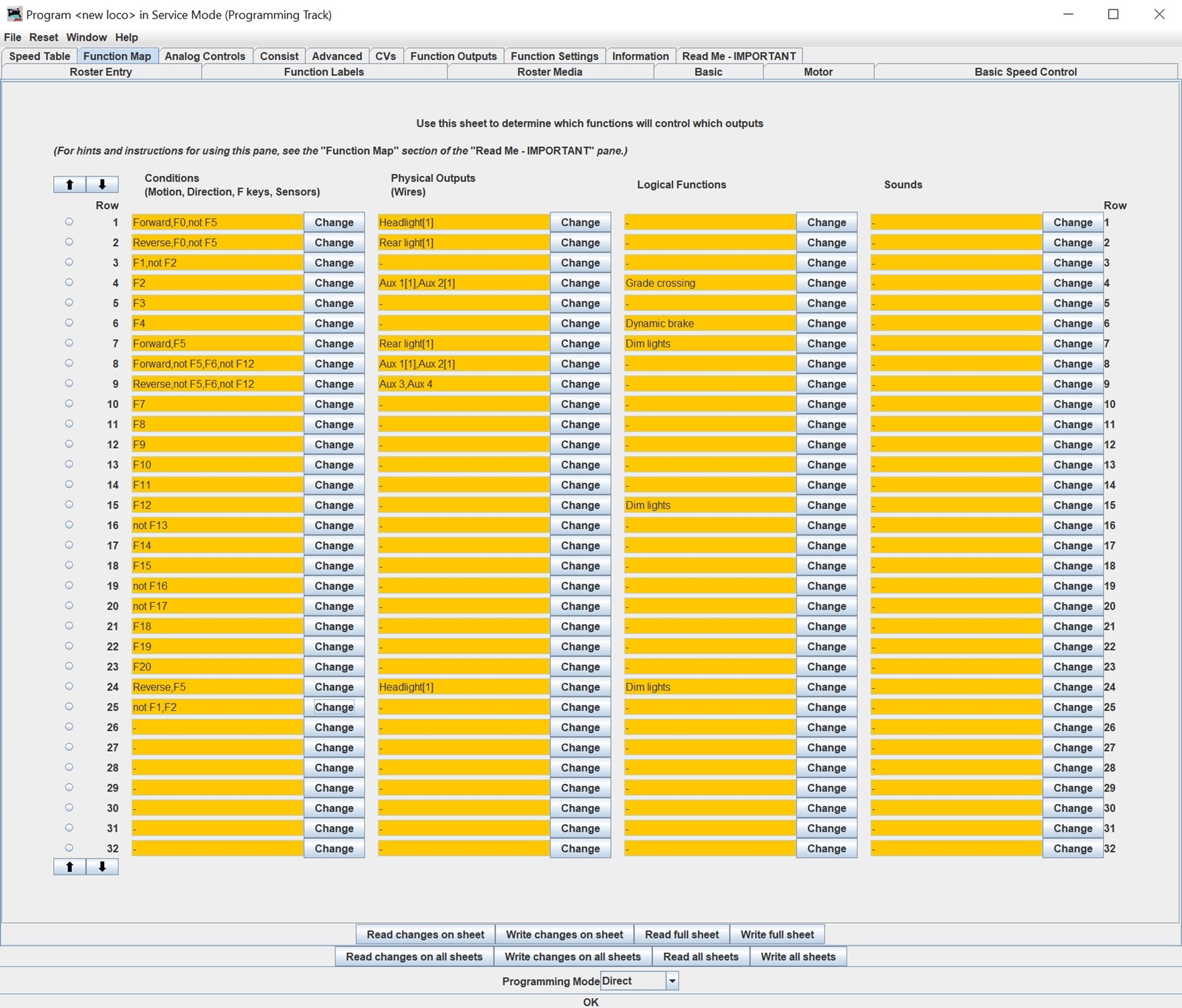

Download LokPilot configuration file for:
- ESU LokProgrammer
- JMRI (import ESU file)
Conclusion - the competition will have a hard time trying to catch up
This is the second foray by Scaletrains.com in to the N scale locomotive market, after their astounding GTEL 8500 "Big Blow". In my opinion, it is a total success. The brand 'Rivet Counter' speaks for itself and does not disappoint. I can't imagine if one day ScaleTrains.com will extend their 'Museum Quality' brand to N-scale...
The Quality/Price ratio is way above the competition; the number and variety of details is just amazing. The ESU Sound-equipped version is proposed at $204.99; to be compared to the ESU Sound-equipped Intermountain SD-40 series that are sold in the $180-$190 range on-line, and for a bit more in hobby shops. Given the quality issues with the Intermountain model, there is no debate that $20 difference is not even worth hesitating. By the way, ScaleTrains.com has adopted a fixed-price policy, i.e. you can buy from them directly at the same price offered by large, on-line hobby shops. Given that they offer free shipping for in-stock orders over $99 in the USA, it's better to order from them directly; this is what I did. Also if you would like the DCC no-sound version, I recommend that you buy the ESU LokPilot directly from them, as you might have difficulty sourcing the Next18 decoders outside from Europe; ScaleTrains sells it at the very fair price of $31.99; you will not get a better deal in Europe or with other brands.
It will be interesting to compare the "soon"(*) to be released Intermountain Tier 4 GEVO. According to the announcement, IMR has taken over the model from Fox Valley Models that could not complete the project; so we might get a hybrid with the excellent chassis inaugurated by IMR on their SD-40 series, and the excellent detailing provided by FVM. If not, and eventually if we only get the current IMR manufacturing quality for the shells, ScaleTrains.com will remain unrivaled for a while. By chance, there are very few overlaps in the road numbers between the ScaleTrains and the IMR runs; I have counted only one with CSX and two with UP.
(*) "Soon" is a vague notion at Intermountain, which is the undisputed #1 in NOT meeting their deadlines; the scale here is in years.
Goodies - a few videos
Less than two weeks after these models were released, I found a number of video reviews. I decided to focus on this written article with photos. However, I have inserted below two good videos that will complete the overview of this model. One is the official promotional video by ScaleTrains.com - highlighting the detailing - and the other one is from Youtuber DaBob's ManCave; this review focuses on model features and performance.
Credits
The copyright of this article is held by Alain LM, who grants TroveStar the right to display it.
Except where otherwise mentioned, all images are copyrighted by the author.
Click here to see all ScaleTrains.com Tier 4 GEVOs on TroveStar
